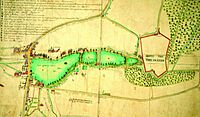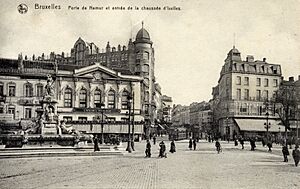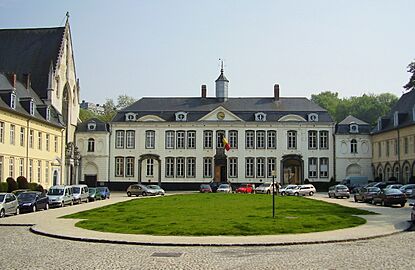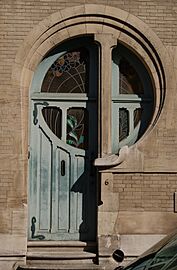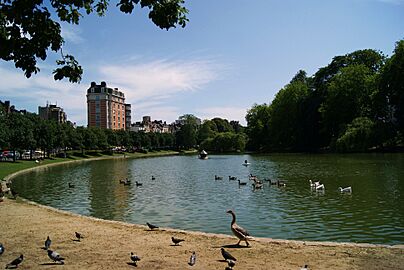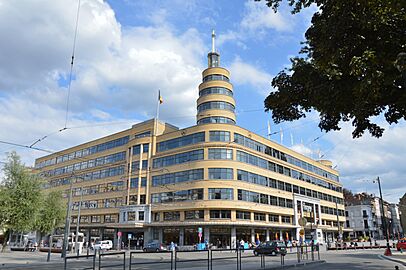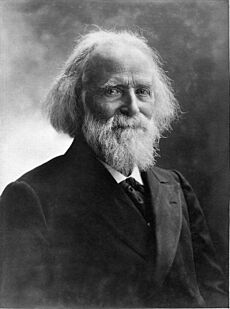Ixelles facts for kids
Quick facts for kids
Ixelles
|
|||
|---|---|---|---|
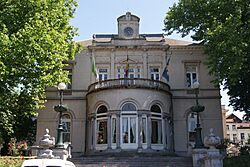
Ixelles' Municipal Hall seen from the Place Fernand Cocq/Fernand Cocqplein
|
|||
|
|||
| Country | Belgium | ||
| Community | Flemish Community French Community |
||
| Region | Brussels | ||
| Arrondissement | Brussels-Capital | ||
| Area | |||
| • Total | 6.34 km2 (2.45 sq mi) | ||
| Population
(2018-01-01)Lua error in Module:Wd at line 1575: attempt to index field 'wikibase' (a nil value).
|
|||
| • Total | Lua error in Module:Wd at line 1,575: attempt to index field 'wikibase' (a nil value). | ||
| Postal codes |
1050
|
||
| Area codes | 02 | ||
| Website | www.ixelles.be www.elsene.be |
||
Ixelles (in French) or Elsene (in Dutch) is one of the 19 areas that make up the Brussels-Capital Region in Belgium. It is located south-east of the main city center of Brussels. What's interesting is that the City of Brussels itself cuts Ixelles into two separate parts! Ixelles also shares borders with other nearby areas like Auderghem, Etterbeek, Forest, Uccle, Saint-Gilles, and Watermael-Boitsfort.
As of January 1, 2023, about 88,521 people live in Ixelles. The area covers about 6.41 square kilometers (2.47 square miles). This means it's quite crowded, with about 13,807 people living in each square kilometer. Like all areas in Brussels, Ixelles uses both French and Dutch officially. It's often seen as a wealthy part of the region. It's also well-known for its large communities of people from other European countries and from Congo.
Contents
Exploring Ixelles: Its Location and Layout
Ixelles is in the south-east part of Brussels. It's split into two sections by a long road called Avenue Louise/Louizalaan. This road is actually part of the City of Brussels itself.
Two Sides of Ixelles
The smaller western part of Ixelles includes a street called Rue du Bailli/Baljuwstraat. It stretches from Avenue Louise towards Avenue Brugmann/Brugmannlaan. The larger eastern part of Ixelles is home to campuses of Brussels' two main universities. These are the French-speaking Université libre de Bruxelles (ULB) and the Dutch-speaking Vrije Universiteit Brussel (VUB). This area also has a famous square called Place Eugène Flagey. Just south of Ixelles, you'll find a large park called the Bois de la Cambre/Ter Kamerenbos.
How Avenue Louise Divided Ixelles
In 1847, the city decided to build Avenue Louise. It was planned as a grand road lined with chestnut trees. The goal was to make it easier to get from Brussels' city center to the popular Bois de la Cambre park. This road was also meant to be the first "Haussmann-style" street in the city. This style is known for wide avenues and grand buildings, like those in Paris.
However, the town of Ixelles didn't want the road to go through its land. At that time, Ixelles was a separate local area from the City of Brussels. After many years of talks that didn't go anywhere, Brussels finally took over the narrow strip of land needed for the avenue in 1864. They also took the Bois de la Cambre park. This decision is why the City of Brussels has an unusual shape today. It's also why Ixelles is split into two separate parts.
A Look Back: The History of Ixelles
Ixelles has a long and interesting history, going back many centuries.
Early Beginnings in the Middle Ages
The name "Ixelles" was first written down in 1210 as Elsela. This name comes from an old Dutch word meaning "alder woods." The village started when La Cambre Abbey was founded. In 1201, a ruler named Henry I, Duke of Brabant gave land to a nun named Gisela. She then started the Abbey. In 1210, she also got land where the duke ordered a mill to be built.
The wet, marshy lands around the Abbey were later drained and cleaned up. This created four springs that provided fish for the Abbey's residents and nearby small villages. The Abbey was located near the springs of the Maelbeek river. This area was part of the Sonian Forest. The part of the forest closest to Brussels became known as the Bois de la Cambre/Ter Kamerenbos later on. The Abbey was officially recognized in 1202. Two famous people who lived there in the 1200s were Boniface of Brussels and Alice of Schaerbeek.
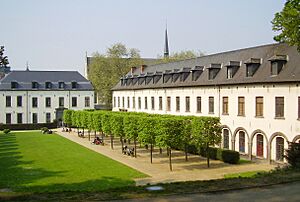
Around the year 1300, during the time of John II, Duke of Brabant, a place to eat was built near the Abbey. It served meals to the people who worked in the forest, cutting wood. Soon, a small village and a few chapels were built. One of these was the Church of the Holy Cross, which opened in 1459. It is said that the Bishop of Cambrai brought two pieces of the original cross with him. At first, these villages and services were for the workers who helped drain the marshlands. Back then, part of Ixelles belonged to Brussels, and another part was owned by a local lord.
Before the French Revolution
In 1478, wars between Louis XI of France and Maximilian I, Holy Roman Emperor caused a lot of damage to the Abbey and the surrounding areas. In 1585, during the time when the Spanish ruled the Netherlands, the Spanish burned down most of the buildings. They did this to stop them from being used as a hiding place by Calvinists. The Abbey was rebuilt in time for the special entry of Archdukes Albert and Isabella in 1599. More large houses and castles were built in Ixelles in the 1500s. This slowly turned the small village into a full-fledged town.
Because of the clean water from the Maalbeek springs, a beer-making industry started in the area. It began inside the Abbey, but by the 1500s, it had grown outside its walls. In 1602, the Council of Brabant made it easier to make beer. This caused the industry to grow even more, creating a lively scene by the springs. By the 1600s and 1700s, about 20 breweries and pubs had opened in Ixelles.
Becoming an Independent Municipality
In 1795, after the French Revolution, the French government declared Ixelles a separate municipality. This happened to many other towns around Brussels. The areas of Neder-Elsene ("Lower Ixelles," where the Abbey is), Opper-Elsene ("Upper Ixelles," a Brussels suburb), Boondaal, Tenbos, and Solbos all became part of Ixelles. Also, the Abbey stopped being a religious place. It was used as a cotton factory, a farm, a military school, and a hospital.
Many of the old medieval gates of Brussels were taken down. More streets were built to help people move to the suburbs. Ixelles' population grew a lot, from 677 people in 1813 to over 58,000 in 1900. With this huge growth, the area also became more French-speaking.
By the late 1800s, some of the ponds were drained, leaving only the famous "Ixelles Ponds." A new Church of the Holy Cross was built in 1860. The first trams appeared in 1884, and the first movie theater opened in 1919. By then, Ixelles and Avenue Louise had become one of the most popular and stylish areas of Brussels. Artists and famous people moved in. This led to new types of buildings, like those in the Art Nouveau and Art Deco styles.
Matongé: A Vibrant African Community
Ixelles is well-known in Belgium for its large community of people from Sub-Saharan Africa. Most of these people live near the Namur Gate and the Chaussée d'Ixelles/Elsensesteenweg. This neighborhood is often called Matongé. It's named after a famous marketplace in Kinshasa, the capital of the Democratic Republic of the Congo.
The History of Matongé in Ixelles
The heart of Matongé in Ixelles started in the late 1950s. This was when "Maisaf" (short for "African House") was founded. It was a center and home for university students from the Belgian Congo. After Congo became independent in 1960, many people from the new country moved to this area. They shaped the neighborhood to look like the original Matongé in Kinshasa. During the 1960s and 1970s, the area was a popular meeting spot for students and diplomats from Zaire (now the Democratic Republic of the Congo). People from other African countries, like Rwanda, Burundi, Mali, Cameroon, and Senegal, also live here.
Shopping and Culture
Two famous shopping areas, the Galerie d'Ixelles and the Galerie de la Porte de Namur, are in the center of Matongé. In these galleries and nearby streets, you can find many special food shops. The area is also famous for its clothes, shoes, fabric shops, hairdressers, wigmakers, bookstores, jewelers, and craft shops. This makes it a must-visit place for many people, both local and international. Over 45 different nationalities live and work here. Many visitors come to Matongé to enjoy African fashion and the lively atmosphere.
Every year since 2001, a successful multicultural festival called Matongé en Couleurs is held in late June. This date is chosen to celebrate Congolese independence. A movie called Juju Factory, released in 2006, was partly filmed in this area. The local TV channel BX1 also has a weekly show called Téle Matongé XL.
The pedestrian street Rue Longue Vie/Lange-Levenstraat is full of snack bars that sell African food. Many of these places have been decorated by a famous Afro-European artist named John Bush. One place, Le Soleil d'Afrique, is almost like his museum, showing his original paintings and decorated furniture.
Main Places to See in Ixelles
Ixelles has many interesting places to visit and explore.
- The buildings of La Cambre Abbey are very close to Ixelles. They are home to a famous art school, the National Geographic Institute, and local church activities.
- The Ixelles Ponds and Tenbosch Park are beautiful parks right in the middle of the municipality.
- The Streamline Moderne Flagey Building on the Place Eugène Flagey is also known as the Maison de la Radio. It used to be the headquarters for Belgium's national radio station.
- The Résidence de la Cambre was the first tall building in Brussels. Located on the Boulevard Général Jacques/Generaal Jacqueslaan, it's another important Art Deco building.
- In the early 1900s, Ixelles was a center for Art Nouveau architecture. Several Art Nouveau houses built by Victor Horta are part of a UNESCO World Heritage Site. Some of them can be visited.
- Three Brussels universities have campuses in Ixelles: Université libre de Bruxelles (ULB), Vrije Universiteit Brussel (VUB), and Saint-Louis University. This means the south-eastern part of Ixelles has many students.
- Ixelles Cemetery is one of the most important cemeteries in Belgium. Many famous Belgian people are buried there.
- Ixelles also has several interesting churches and museums. These include a fine-arts museum and the Constantin Meunier Museum. This museum is in the house where the artist lived for part of his life.
-
View from the main courtyard of Abbey of La Cambre, near Ixelles.
-
View of the Ixelles Ponds towards the Place Eugène Flagey.
Events and Festivals
Ixelles hosts several fun events throughout the year.
Annual Fairs
- The Spring Fair takes place on the Place Eugène Flagey. It happens between the fourth and sixth Sunday after Easter.
- The Boondael Fair is held at the end of July.
People and Their Origins in Ixelles
Ixelles is a very diverse place with people from many different countries.
Population Diversity (2020 Data)
Here are some of the largest groups of people from other countries living in Ixelles as of January 1, 2020:
| 11,470 | |
| 4,504 | |
| 2,540 | |
| 1,795 | |
| 1,793 | |
| 1,750 | |
| 1,378 | |
| 1,188 | |
| 1,107 | |
| 1,045 |
Population Breakdown (2023 Data)
This table shows the different groups of people living in Ixelles in 2023:
| Group of origin | Year | ||||
|---|---|---|---|---|---|
| 2023 | |||||
| Number | % | ||||
| Belgians with Belgian background | 20,038 | 22.64% | |||
| Belgians with foreign background | 23,999 | 27.11% | |||
| Neighbouring country | 3,587 | 4.05% | |||
| EU27 (excluding neighbouring country) | 3,657 | 4.13% | |||
| Outside EU 27 | 16,755 | 18.93% | |||
| Non-Belgians | 44,484 | 50.25% | |||
| Neighbouring country | 15,519 | 17.53% | |||
| EU27 (excluding neighbouring country) | 16,208 | 18.31% | |||
| Outside EU 27 | 12,757 | 14.41% | |||
| Total | 88,521 | 100% | |||
Global Connections: Twin Towns
Ixelles has special connections with several towns around the world. These are called "twin towns" or "sister cities." They often share cultural exchanges and friendships.
 Biarritz, France (since 1958)
Biarritz, France (since 1958) Kalamu, a municipality in Kinshasa, Democratic Republic of the Congo (since 2003)
Kalamu, a municipality in Kinshasa, Democratic Republic of the Congo (since 2003) Zababdeh, Palestine (since 2003)
Zababdeh, Palestine (since 2003) Kibbutz Megiddo, Israel (since 2012, this partnership was paused in July 2024)
Kibbutz Megiddo, Israel (since 2012, this partnership was paused in July 2024) Lichtenberg, Germany
Lichtenberg, Germany
Famous People Connected to Ixelles
Many notable people have either been born in Ixelles or lived there.
Born in Ixelles
- Agnès Varda (1928-2019), a famous film director.
- Audrey Hepburn (1929–1993), a British actress, model, and humanitarian.
- Auguste Perret (1874–1954), a well-known architect.
- Emile Vandervelde (1866–1938), a statesman and socialist leader. He served as Minister of Justice and Foreign Affairs.
- Frank Ntilikina (born 1998), a professional basketball player.
- Jacky Ickx (born 1945), a famous racing driver.
- Julio Cortázar (1914–1984), a novelist.
- Sophie Wilmès (born 1975), a politician who served as Prime Minister of Belgium.
- Ursula von der Leyen (born 1958), a German politician who is the President of the European Commission.
- Yannick Carrasco (born 1993), a football player.
Lived in Ixelles
- Antoine Wiertz (1806–1865), a painter and sculptor.
- Auguste Rodin (1840–1917), a famous sculptor.
- Charles de Coster (1827–1879), a novelist.
- Constantin Meunier (1831–1905), a painter and sculptor.
- Edith Cavell (1865–1915), a British nurse and World War I hero. She ran a nursing school in Ixelles.
- Ernest Solvay (1838–1922), a chemist, industrialist, and generous giver to good causes.
- Giacomo Puccini (1858–1924), a famous Italian composer. He lived and died in Ixelles.
- Karl Marx (1818–1883), a German philosopher and social thinker.
- Vladimir Lenin (1870–1924), a Russian revolutionary.
See also
 In Spanish: Ixelles para niños
In Spanish: Ixelles para niños





